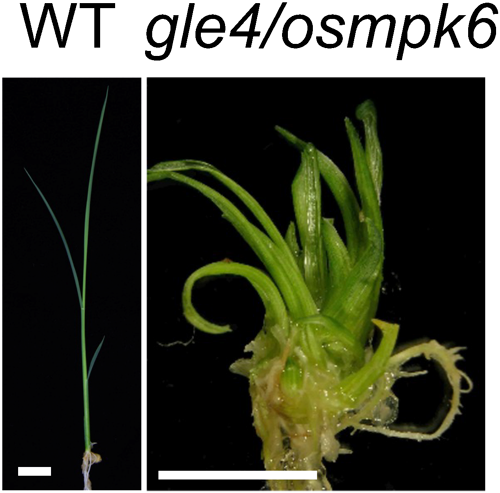- 著者
- Kiyoe Ishimoto Misuzu Nosaka-Takahashi Mitsuko Kishi-Kaboshi Tsuneaki Watanabe Kiyomi Abe Sae Shimizu-Sato Hirokazu Takahashi Mikio Nakazono Hirohiko Hirochika Yutaka Sato
- 出版者
- Japanese Society for Plant Biotechnology
- 雑誌
- Plant Biotechnology (ISSN:13424580)
- 巻号頁・発行日
- pp.22.1117a, (Released:2023-01-23)
- 参考文献数
- 25
In plants, mitogen activated protein kinases (MPKs) are involved in various signaling pathways that lead to biotic and abiotic responses as well as that regulate developmental processes. Among them, MPK6 and its closely related homologue, MPK3, act redundantly and are known to be involved in asymmetric cell divisions of meristemoid mother cells in stomata development and of zygotes in Arabidopsis. Loss-of-function mutants of GLE4/OsMPK6, which is an orthologue of MPK6 in rice, showed a defect in polarity establishment in early stage of embryogenesis. However, because of the embryo lethality of the mutations, the function of GLE4/OsMPK6 in post-embryonic development is not clarified. Here, we report the analysis of post embryonic function of GLE4/OsMPK6 in vegetative stage of rice using regenerated gle4/osmpk6 homozygous plants from tissue culture. The regenerated plants are dwarf and produce multiple shoots with small leaves. These shoots never develop into reproductive stage, instead, proliferate vegetative shoots repeatedly. Leaves of gle4/osmpk6 have small leaf blade at the tip and blade-sheath boundary become obscure. Stomata arrangement is also disturbed in gle4/osmpk6 leaf blade. The shape of shoot apical meristem of gle4/osmpk6 become disorganized. Thus, GLE4/OsMPK6 functions in shoot organization and stomata patterning in the post embryonic development in rice.
- 著者
- Mitsuko Kishi-Kaboshi Fumitaka Abe Yoko Kamiya Kanako Kawaura Hiroshi Hisano Kazuhiro Sato
- 出版者
- Japanese Society for Plant Biotechnology
- 雑誌
- Plant Biotechnology (ISSN:13424580)
- 巻号頁・発行日
- vol.40, no.3, pp.237-245, 2023-09-25 (Released:2023-09-25)
- 参考文献数
- 36
- 被引用文献数
- 1
Genome editing is a promising method for simultaneously mutagenizing homoeologs in the three subgenomes of wheat (Triticum aestivum L.). However, the mutation rate via genome editing must be improved in order to analyze gene function and to quickly modify agronomic traits in wheat. Here, we examined the Cas9-induced mutation rates in wheat plants using two promoters for single guide RNA (sgRNA) expression and applying heat treatment during Agrobacterium tumefaciens-mediated transformation. Using the TaU6 promoter instead of the OsU6 promoter from rice (Oryza sativa L.) to drive sgRNA expression greatly improved the Cas9-induced mutation rate. Moreover, a heat treatment of 30°C for 1 day during tissue culture increased the Cas9-induced mutation rate and the variety of mutations obtained compared to tissue culture at the normal temperature (25°C). The same heat treatment did not affect the regeneration rates of transgenic plants but tended to increase the number of transgene integration sites in each transgenic plant. These results lay the foundation for improving the Cas9-induced mutation rate in wheat to enhance research on gene function and crop improvement.
- 著者
- Mitsuko Kishi-Kaboshi Ayako Nishizawa-Yokoi Ichiro Mitsuhara Seiichi Toki Katsutomo Sasaki
- 出版者
- Japanese Society for Plant Biotechnology
- 雑誌
- Plant Biotechnology (ISSN:13424580)
- 巻号頁・発行日
- vol.40, no.2, pp.157-165, 2023-06-25 (Released:2023-06-25)
- 参考文献数
- 24
- 被引用文献数
- 1
Chrysanthemum morifolium is one of the most popular ornamental plants in the world. However, as C. morifolium is a segmental hexaploid, self-incompatible, and has a sizable heterologous genome, it is difficult to modify its trait systematically. Genome editing technology is one of the attractive methods for modifying traits systematically. For the commercial use of genetically modified C. morifolium, rigorous stabilization of its quality is essential. This trait stability can be achieved by avoiding further genome modification after suitable trait modification by genome editing. Since C. morifolium is a vegetatively propagated plant, an approach for removing genome editing tools is required. In this study, we attempted to use the piggyBac transposon system to remove specific DNA sequences from the C. morifolium genome. Using the luminescence as a visible marker, we demonstrated that inoculation of Agrobacterium harboring hyperactive piggyBac transposase removes inserted 2.6 kb DNA, which harbors piggyBac recognition sequences, from the modified Eluc sequence.


